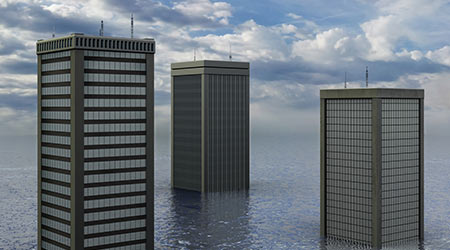
The Institute of Inspection, Cleaning, Restoration and Certification (IICRC), a nonprofit standards-setting and credentialing body for the inspection, cleaning and restoration industry, is offering business owners a list of self-mitigation strategies to limit their losses until professional help arrives.
“Once flood waters retreat, it’s important to act quickly, but appropriately, to mitigate flood damage to homes and businesses,” said IICRC Chairman Pete Duncanson.
Before entering a building where flood damage may have occurred, make sure it’s safe: check for electrical hazards and structural damage, and use proper protective gear like boots, gloves and respirators. Before starting any construction or repairs, check for common hazardous materials like lead paint and asbestos, which may require help from professional and state-licensed contractors.
Then, follow these tips:
1. Act quickly. The severity of damage escalates the longer water sits and building components and contents stay wet. Mold will grow within 48-72 hours, so aim to start removing water and drying the environment as soon as possible.
2. Ventilate affected areas to prevent mold growth. Mold loves moisture and organic materials such as paper or particleboard. In order to mitigate damage, open windows if weather permits and maintain moderate temperatures.
3. Assess damage to items and materials. Assess the type of water absorbed by items, such as rainwater, water from broken pipes, contaminated river water or bacteria-filled sewage, when salvaging items. The IICRC strongly recommends that in water damages where there are contaminants present (e.g., bacteria, sewage, mold) or where small children or immune-compromised individuals are present, that an inspection be conducted by a trained restorer and remediator.
4. Take photos. It may be helpful to keep a record of activities before, during and after cleanup for insurance purposes. Take photos or video to inventory damage as well as discarded material.
5. Expose pockets of saturation. Hidden and concealed pockets of water, such as in layers between building materials, need to be opened for cleaning and drying. Wet carpets can usually be dried by professionals with the right equipment, but carpet padding, which is like a big sponge, should be discarded. Wood base trim and hardwood can also be saved with the right equipment if they can be accessed and completely dried on both sides.
Remember to investigate concealed cavities such as behind walls, in mechanical spaces, under cabinets and furniture, and in crawl spaces.
6. Conduct a thorough cleaning. Durable, non-porous or semi-porous materials, such as studs and joists, hardwood flooring and vinyl products, can be cleaned with common cleaning products or specialized products with detergents. After a thorough cleaning of salvageable materials, a disinfectant solution may need to be applied in case of harmful bacteria from sewage, river water debris or even standing water that has gone bad. If vacuuming, use a HEPA-filter vacuum to remove allergens, fine dust and spores.
7. Confirm drying before reconstruction. In order to prevent dry rot and structural damage, it’s important not to reconstruct or cover wood and other wet materials until the moisture content has been adequately reduced. A water restoration professional can confirm proper drying before reconstruction.
Immediately after a storm, a business owner should contact their insurance provider for a storm damage assessment by an adjuster. Insurance companies can often provide a list of credible restoration companies from which owners can choose.
To find a list of certified restorers in your area, or to confirm the certification of any company that has contacted you, visit http://www.iicrc.org/locate-acertified-professional/.

 The Down and Dirty on Cleaning in Virus Season
The Down and Dirty on Cleaning in Virus Season How Surfactant Use is Expanding in Commercial Cleaning
How Surfactant Use is Expanding in Commercial Cleaning Clean Buildings Conference
Clean Buildings Conference